Pedro Gartland
Pedro Gartland (c. 1840 - 1908) was an American businessman and war veteran settled in Argentina towards beginnings of 1860.[2] He died assassinated in an attack perpetrated inside his house in June 1908.[3]
Pedro A. Gartland | |
|---|---|
 | |
| Personal details | |
| Born | Peter. A. Gartland c. 1840 Maine, United States |
| Died | July 8, 1908 Buenos Aires, Argentina |
| Resting place | Cementerio Británico |
| Spouse(s) | Isidora Moyano de Gartland |
| Occupation | entrepreneur lender soldier |
| Signature | |
| Military service | |
| Allegiance | Union |
| Branch/service | United States Army |
| Years of service | 1861-1863 |
| Rank | Soldier |
| Battles/wars | American Civil War.[1] |
He was born possibly in Maine, United States of America, the son of a family of Irish descent. Arrived in Buenos Aires around 1864, he dedicated himself to different undertakings including that of a moneylender.[4] He was also involved in the administration of the Tranvía a Vapor del Oeste, one of the main tram lines in the city of Buenos Aires.[5]
In 1889 Pedro A. Gartland took part in the founding of an Irish colony in Napostá, city of Bahía Blanca.[6] The case of his brutal murder was solved after several years. Among the suspects were several close associates of the victim.[7]
References
- Ireland and the Americas: Culture, Politics, and History. James Patrick Byrne, Philip Coleman, Jason Francis King. 2008. ISBN 9781851096145.
- Revista del Museo Mitre, Temas5-9. Museo Mitre, 1952. 1952.
- Revista jurídica y de ciencias sociales. República Argentina. 1910.
- Boletin de la Academia Nacional de Ciencias, Volumen3. Academia Nacional de Ciencias en Córdoba. 1879.
- Leyes, contratos y resoluciones referentes á los ferrocarriles y tranvías á tracción mecánica de la Republica Argentina ..., Volúmenes3-4. República Argentina. 1904.
- Becoming Gauchos Ingleses: Diasporic Models in Irish-Argentine Literature. Edmundo Murray. 2009. ISBN 9781933146676.
- Revista argentina de ciencias políticas, Volumen23. Rodolfo Rivarola, Horacio C. Rivarola, Mario A. Rivarola. 1922.